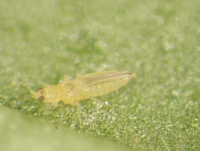
Features
Crop Protection
Inputs
Greenhouse Grower Notes: Global ties can create a dilemma
April 30, 2008 By Graeme Murphy
The global nature of the industry also exposes a glaring Achilles heel
It is a strange irony that one of the key strengths of the greenhouse ornamental industry is also one of its major weaknesses.
 |
| Pink Hibiscus Mealybug. DIVISION OF PLANT INDUSTRY ARCHIVE, FLORIDA DEPARTMENT OF AGRICULTURE AND CONSUMER SERVICES, BUGWOOD.ORG |
It is a strange irony that one of the key strengths of the greenhouse ornamental industry is also one of its major weaknesses. The protected nature of the greenhouse provides an environment that allows for predictable and consistent growing conditions almost anywhere in the world. As a result, the industry is about as global as any industry can be. Technologies, growers and plant material move freely from one continent to another, versatile enough to find a home wherever there is a greenhouse. It has been one of the primary reasons for its success. Advances in research, technology and plant breeding, no matter where they occur, can be applied elsewhere, and rapid adoption of change is characteristic of the industry.
However, the global nature of the industry also exposes a glaring Achilles heel. New plant material plays a vital role in the development of the industry, and Canadian growers routinely bring cuttings or seedlings into their greenhouses from North America, Central America, Europe, Africa, the Middle East and Asia. Inevitably, we finish up sharing more than just new plant breeding. It is no coincidence that the major pests and diseases of greenhouse ornamental crops are common to all major production areas in the world. When we rhyme off the top pests – thrips, whiteflies, spider mites, aphids, fungus gnats, leafminer and mealybugs – we could be in any one of many different countries. The same can be said of the major diseases.
From a Canadian perspective, the influx of new pest problems seems to have begun back in the early 1980s. Prior to that, we had to deal with aphids, spider mites, greenhouse whiteflies and fungus gnats – simpler times to be sure. Things changed when the American serpentine leafminer emerged as a serious pest of the North American chrysanthemum industry, followed closely in the mid-1980s by the western flower thrips, and in the late 1980s by the sweet potato whitefly. We are not alone in sharing these new and unwanted plant companions. In Holland, they still call western flower thrips the California thrips, in honour of its homeland.
 |
| Chilli Thrips ANDREW DERKSEN, UNIVERSITY OF FLORIDA, BUGWOOD.ORG |
At times, as with the pests described above, these new additions merge into the production landscape for local growers and quickly become just another irritant that has to be dealt with on a regular basis. For other pests, however, the implications are more serious. Those pests and diseases that are regulated either by Canada or the U.S. (i.e., quarantine pests) have the potential to disrupt the industry in a major way. The recent outbreak of Duponchelia fovealis in Ontario is an obvious example. Chrysanthemum white rust and Ralstonia are two diseases that in recent years have caused similar disruption. Control of some of these pests may not be that difficult. The problem with regulated pests, however, is that control is not good enough; they have to be eradicated. Control may be easy, but eradication is usually very difficult. In these types of situations, the flaws in the globalized nature of this industry are quickly (and often very damagingly) exposed.
Unfortunately, it is not always easy to predict what new pests we can expect to deal with in the future. One thing we can do is to look at new pest outbreaks in other areas of the world and use that information to stay on guard. For example, in the U.S. at the moment, there is concern about a number of greenhouse pests that have been found in recent years.
The chilli thrips (Scirtothrips dorsalis) was found in ornamental crops in Florida in 2005 and has a wide host range. The pink hibiscus mealybug (Maconellicoccus hirsutus) is a serious pest in many tropical areas of the world and was found for the first time in the Caribbean in the mid-1990s. Since then Florida has been watching for this pest and it was eventually found in a couple of counties in 2002. It too has a very wide host range including many ornamental plants, so it could become a widespread greenhouse pest. Another pest, the red palm mite (Raoiella indica) has been found on one Caribbean island after another over the last few years and in late 2007 was found for the first time in Florida (there’s something about Florida and invasive pests). It has the potential to cause serious damage to ornamental palms.
Will any of the above pests become major problems in the Ontario or Canadian industry? It is difficult to know. In 1990, a new thrips pest (the melon thrips, Thrips palmi) was found in Florida (where else?) and has since become well established. At that time, there was concern that it too could become another greenhouse pest with an appetite for a wide range of ornamental plants. However, although it has been intercepted on a number of occasions in Europe on ornamental plants, there is no indication (yet) that it has made it to Canada.
The industry thrives on the global movement of plant material, but there are obvious disadvantages with no easy solutions. Isolating ourselves and allowing no plant material in from anywhere else would be as quick a way as any to kill the industry. Equally, it is unrealistic to expect that the vast quantities of plant material entering the country can be inspected thoroughly enough to intercept all pests and diseases. Until a better solution is found, growers need to become involved as well, taking personal responsibility for monitoring all their incoming plant material, so that pest problems can be addressed quickly before they get out of hand. We work in a truly global industry, everyone sharing in the progress, but unfortunately also sharing our pests and diseases. Overcoming this dilemma provides a huge challenge for industry, government and research.
Graeme Murphy is the greenhouse floriculture IPM specialist with the Ontario Ministry of Agriculture, Food and Rural Affairs at Vineland.
• 905-562-4141, ext. 106, or graeme.murphy@ontario.ca
Print this page